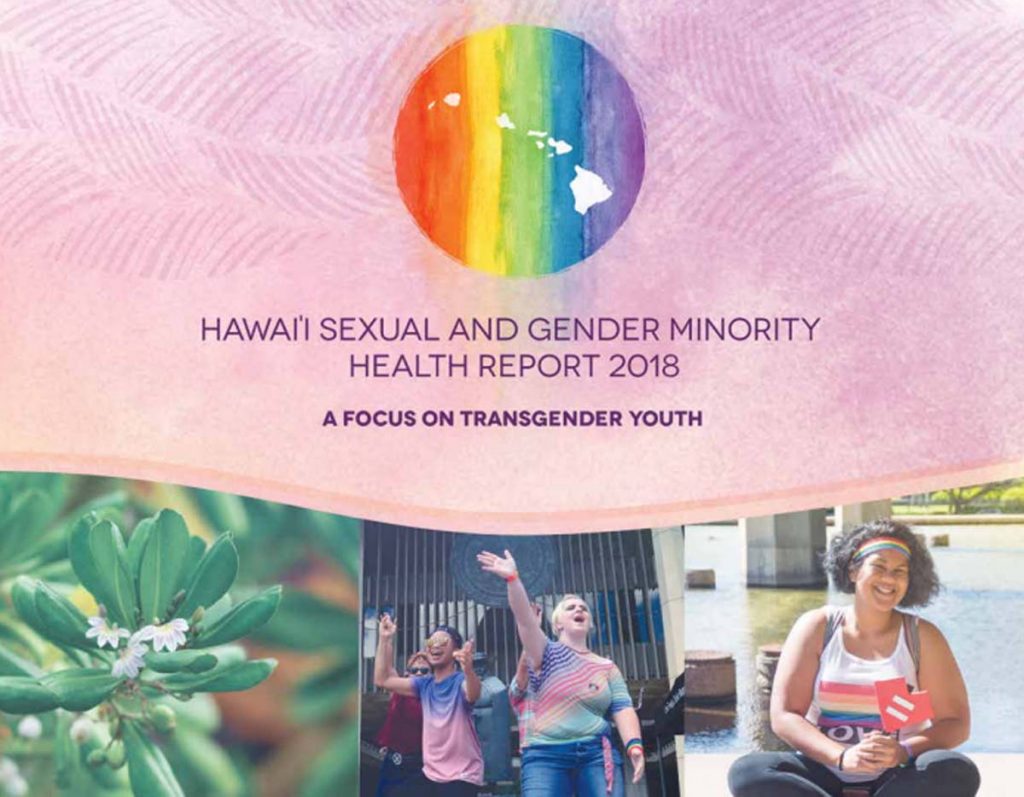First Health Data Report Focused on Hawai‘i Transgender Youth

Hawai‘i Sexual and Gender Minority Health Report 2018. Cover image courtesy Hawaiʻi Department of Health.
The Hawai‘i Department of Health today released the Hawai‘i Sexual and Gender Minority Health Report 2018. This is the first state report with a special focus on health issues faced by Hawai‘i transgender youth. Three percent, or 1,260 public high school students statewide, self-identify as transgender.
The report reveals that transgender youth experience greater health disparities than their peers who identify as cisgender (those whose gender identities conform with their biological sex). This difference is even greater than the one that exists between lesbian, gay and bisexual, and heterosexual youth, according to the Department of Health.
The report also documents the challenges, resiliency and hope for transgender people in Hawai‘i.
The focus of this year’s report was motivated by tremendous support and requests for more data and greater public health action following the completion of the inaugural 2017 Hawai‘i Sexual and Gender Minority Health Report. The 2017 report focused primarily on the health of LGB individuals because data on transgender individuals was insufficient to report at that time.
In response, the Department of Health convened a workgroup with community partners and stakeholders and prioritized a report on health outcomes of transgender youth in Hawai‘i.
“We are so pleased to produce a report that the community truly needed and asked for,” said Health Director Dr. Bruce Anderson. “The valuable input and engagement from community stakeholders was critical to developing the report that is the first-of-its-kind to assess the health of transgender youth in Hawai‘i.”
The Hawai‘i Sexual and Gender Minority Health Report 2018 contains data from the 2017 Hawai‘i High School Youth Risk Behavior Survey, a joint effort between the Departments of Education and Health, administered in odd years to public high schools. This report was made possible because the 2017 survey was the first time a question on gender identity was included.
“We hope the findings will be used by our stakeholders to initiate and sustain efforts to address the health challenges faced by Hawai‘i’s transgender population,” said Lola Irvin, administrator of DOH’s Chronic Disease Prevention and Health Promotion Division. “We must work intentionally to improve the health of our at-risk and underserved populations to move the health of the state forward.”
Important findings of this year’s report showed that transgender youth are significantly more likely to use substances including tobacco, alcohol and other drugs. Transgender youth who are victims of bullying or violence also often face adverse mental health problems, which increases their propensity towards substance abuse and other risky health behaviors.
Additional significant findings of the 2018 report include:
- Only half of transgender youth report that they usually slept at their parent or guardian’s home during the last 30 days, compared to 94 percent of cisgender youth.
- Less than half of transgender youth saw a doctor or nurse for a checkup or physical exam in the past year, compared to two-thirds of cisgender youth.
- More than 30 percent of transgender youth have smoked cigarettes in the past month, compared to only six percent of cisgender youth.
- Transgender youth are nearly three times more likely to report binge drinking in the past month, compared to cisgender youth.
- One-quarter of all transgender youth said they have ever injected an illegal drug, versus only one percent of cisgender youth.
- Forty percent of transgender youth said they have been bullied on school property or online in the last year, compared to 23 percent of cisgender youth.
- One-quarter of transgender youth skipped school because they felt unsafe, compared to only seven percent of cisgender youth.
- Nearly 50 percent of transgender youth said they purposely hurt themselves in the past year, compared to 17 percent of cisgender youth.
- Half of transgender youth attempted suicide in the past year, compared to only eight percent of cisgender youth.
To download a copy of the report, visit health.hawaii.gov/surveillance.










